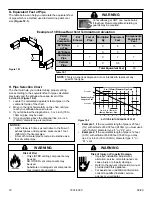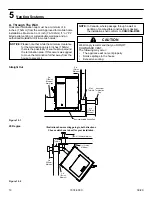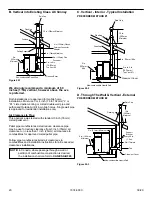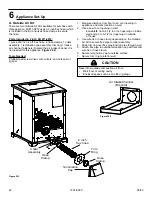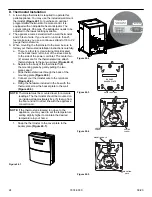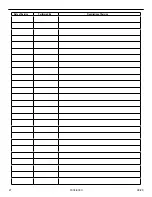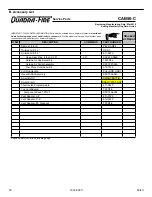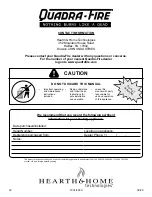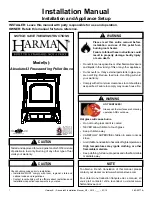
17
09/20
7074-803C
C. Negative Pressure
Negative pressure results from the imbalance of air available
for the appliance to operate properly. It can be strongest in
lower levels of the house.
Causes include:
• Exhaust fans (kitchen, bath, etc.)
• Range hoods
• Combustion air requirements for furnaces, water
appliances and other combustion appliances
• Clothes dryers
• Location of return-air vents to furnace or air conditioning
• Imbalances of the HVAC air handling system
• Upper level air leaks such as:
- Recessed lighting
- Attic hatch
- Duct leaks
To minimize the effects of negative air pressure:
• Install the outside air kit with the intake facing prevailing
winds during the heating season
• Ensure adequate outdoor air for all combustion
appliances and exhaust equipment
• Ensure furnace and air conditioning return vents are not
located in the immediate vicinity of the appliance
• Avoid installing the appliance near doors, walkways or
small isolated spaces
• Recessed lighting should be a “sealed can” design
• Attic hatches weather stripped or sealed
• Attic mounted duct work and air handler joints and seams
taped or sealed
NOTICE:
Hearth & Home Technologies assumes no
responsibility for the improper performance of the
chimney system caused by:
• Inadequate draft due to environmental conditions
• Down drafts
• Tight sealing construction of the structure
• Mechanical exhausting devices
D. Draft
Draft is the pressure difference needed to vent an appliance
successfully. When an appliance is drafting successfully, all
combustion byproducts are exiting the home through the
chimney.
Install through the warm airspace enclosed by the building
envelope. This helps to produce more draft, especially
during lighting and die-down of the fire.
Considerations for successful draft include:
• Preventing negative pressure
• Location of appliance and chimney
NOTE:
Follow venting manufacturers recommendations
for sealing pipe joints.
E. Minimum Vacuum Requirements
.075 inches W.C.
F. Chimney and Exhaust Connection
1.
Chimney & Connector
: Use 3 or 4 inch (76-102mm)
diameter type “L” or “PL” venting system. It can be
vented vertically or horizontally.
2.
Mobile Home:
Approved for all Listed pellet vent. If using
the 3 inch (76mm) vertical Top Vent Adapter Kit or the 3
to 6 inch (76-152mm) Top Vent Offset Adapter, use Listed
double wall flue connector. A Quadra-Fire Outside Air Kit
must be used with manufactured home installations.
3.
Residential:
The 3 inch (76mm) vertical Top Vent
Adapter Kit and the 3 to 6 inch (76-152mm) Top Vent
Offset Adapter are tested to use 24 gauge single wall
flue connector or Listed double wall flue connector to
Class A Listed metal chimneys, or masonry chimneys
meeting International Residential Code standards for
solid fuel appliances.
4.
INSTALL VENT AT CLEARANCES SPECIFIED BY
THE VENT MANUFACTURER.
5. Seal exhaust venting system to the unit with High Temp
500ºF RTV silicone sealant. Secure the venting system
to the unit with at least (3) screws. All pellet vent pipe
must be secured together either by means provided by
the pipe manufacturer or by (3) screws at each joint.
6. DO NOT INSTALL A FLUE DAMPER IN THE EXHAUST
VENTING SYSTEM OF THIS Appliance.
7. DO NOT CONNECT THIS Appliance TO A CHIMNEY
FLUE SERVING ANOTHER APPLIANCE.
Risk of Asphyxiation!
Negative pressure can cause spillage of combustion
fumes and soot.
WARNING
















